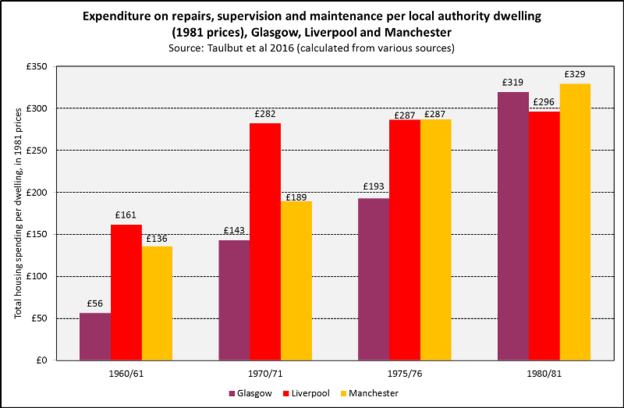Post-war housing changes
The graphs below are derived from GCPH's research on the causes of 'excess mortality' in Glasgow and Scotland.
The nature (and scale) of urban change experienced within Glasgow in the post-war period (1945-1980) was different to that in the comparator cities (of Liverpool and Manchester). This is relevant to population health in terms of social determinants such as housing, living conditions and social and community networks. Glasgow differed from the comparator cities in terms of: larger-scale slum clearances and demolitions; larger within-city (poor quality) peripheral council house estates; greater emphasis on high-rise development; and crucially, much lower per capita investment in housing repairs and maintenance of the public housing stock.
The following graphs illustrate aspects of changes in housing in Glasgow in comparison to other cities.
Levels of overcrowding compared across selected UK cities, 1951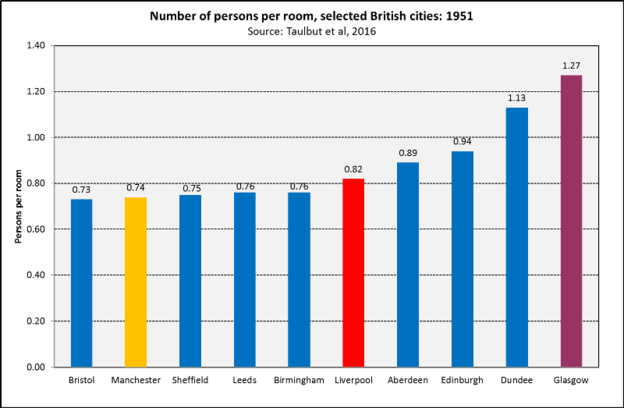 click on graph to expand
click on graph to expand
The graph above shows that in 1951 Glasgow had much higher levels of overcrowding compared to other comparable UK cities. Other evidence from the 'excess mortality' research (not shown), highlighted that in 1971 overcrowding was much higher in Glasgow compared to Liverpool and Manchester across all levels of deprivation and that levels of overcrowding remained higher in Glasgow than in Liverpool and Manchester between the 1980s and 2000s, although overcrowding reduced significantly in all the cities.
Houses demolished/closed in major UK cities, 1955-85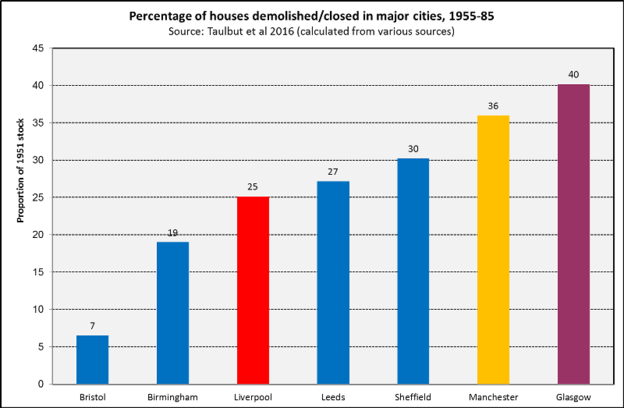
click on graph to expand
The scale of slum clearances and demolitions in Glasgow was greater than in comparable English cities (especially Liverpool). In part this obviously reflects the greater housing challenges faced by Glasgow at the time, but there is also an associated potentially negative impact in terms of the break-up of existing communities and dismantling of social networks.
Dwellings in main post-war housing estates in Liverpool, Manchester and Glasgow, 1980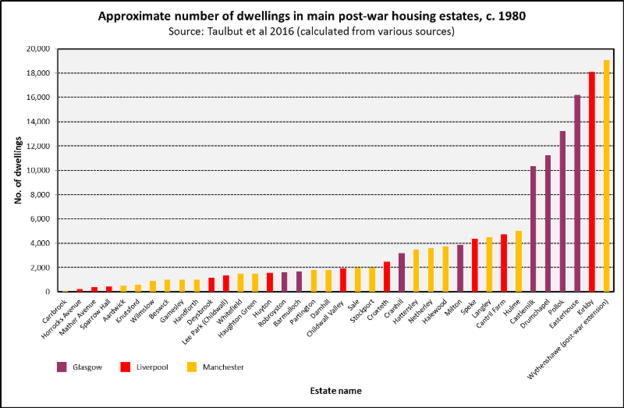 click on graph to expand
click on graph to expand
In Glasgow, there was more building of (poor quality) peripheral council house estates in the post-war period. Although the two English cities also built large estates within the city boundaries, Glasgow built more of them, housing (and impacting on the lives of) a greater number of people.
Rate of high-rise dwellings built by the public sector in selected UK cities, 1945-1975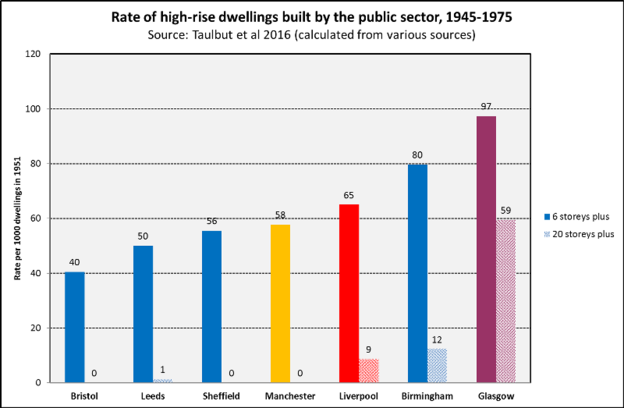
click on graph to expand
There was a much greater emphasis on high-rise development in Glasgow. As the graph above shows, Glasgow built proportionately more blocks of 6+ storeys, but a great many more with 20+ storeys. This is potentially relevant to health because of the known links between high-rise living and negative impacts on mental health.
Expenditure on repairs, supervision and maintenance per local authority dwelling, Glasgow, Liverpool and Manchester
click on graph to expand
The greater scale of within-city council house building in Glasgow was accompanied by much lower investment in housing repairs and maintenance. The graph above shows how Glasgow compared badly in this respect particularly in the earlier period analysed. This chimes with descriptions in a number of social histories of the many, and profound, problems associated with living in poor quality damp housing in the city, and the perceived lack of attention given to the problem by the authorities.
Notes
As noted above these graphs are drawn from GCPH research on the causes of 'excess mortality' in Glasgow and in Scotland. It has been suggested that Glasgow’s high levels of excess mortality may have been influenced by differences (particularly historical differences) in aspects of housing between Scotland and the rest of the UK.
In relation to excess mortality in Glasgow, the research concluded that 'the clearest evidence for differences (especially historical differences) in housing quality between Scotland and England relates to overcrowding. In that sense, this hypothesis links directly to several others – in particular the inadequate measurement of deprivation, the lagged effects of poverty & deprivation, the nature and scale of urban change, lower ‘social capital’, political influences and vulnerability – all of which are likely to have contributed to the development of excess mortality in Scotland and Glasgow.'
For further information on the 'excess mortality' research go to the excess mortality page on the GCPH website.
Additional Resources
-
ResourceThursday, 26 May 2011
Your Better Life Index
A new, interactive index allowing users to measure and compare their lives. -
ResourceWednesday, 18 May 2011
The Sustainable Cities Index
Progress on sustainability, highlighting environmental performance, quality of life and their readiness for the challenges of the future -
ResourceMonday, 1 December 2008
Good Places Better Health
A new approach to environment and health in Scotland

